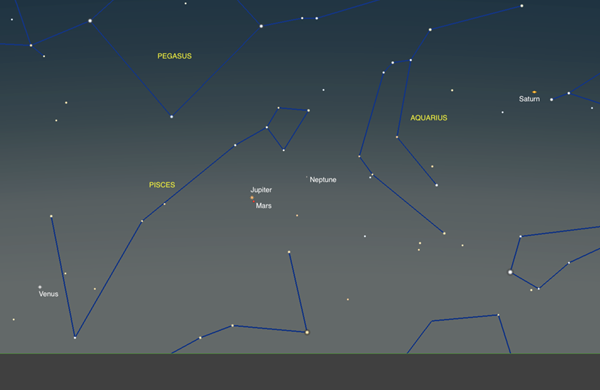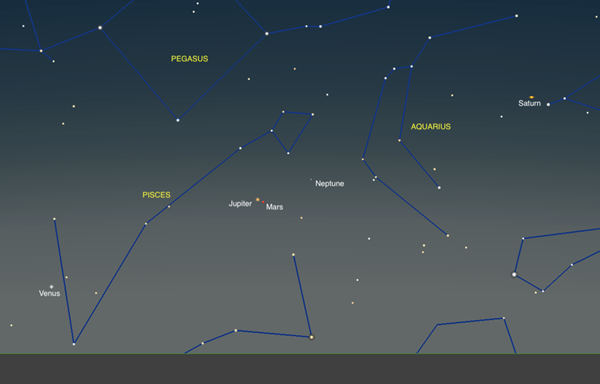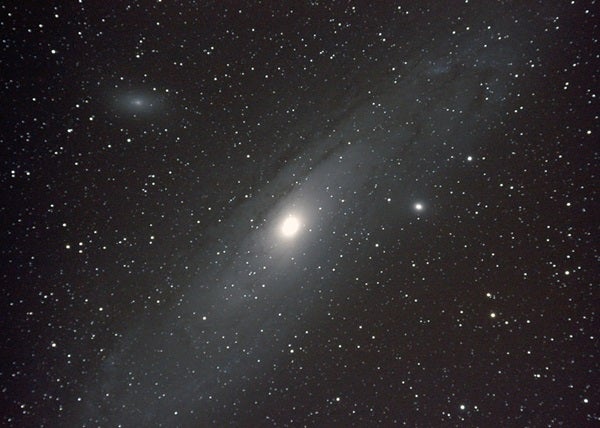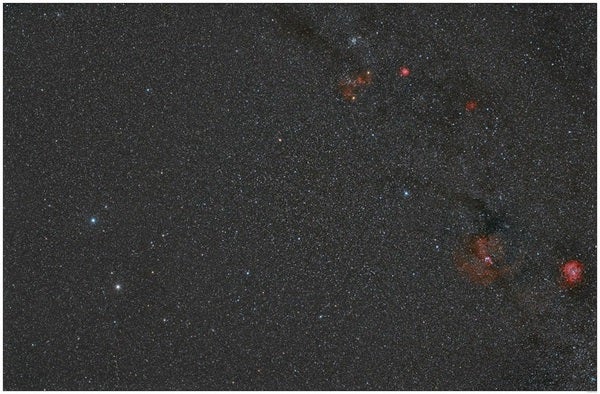Friday, May 27
By an hour after sunset tonight, a brilliant orange jewel has appeared in the southeastern sky. It’s Antares, the red giant “heart” of Scorpius, glowing at magnitude 1.1. Wait another hour or so, and then it’s time to pull out your binoculars and go hunting. Tonight, our targets will be M80 and M4, two globular clusters that lie near Antares in the sky.
Our first stop is M80, which sits 4.5° north-northwest of Antares and spans about 10′ in diameter. It shines at magnitude 7 and is so dense that many observers say it looks a bit like a fuzzy comet with no tail, even in a small scope. See what you think! Note that the bright star to the cluster’s northeast is not a cluster star, but an interloper. It sits between Earth and M80.
From M80, let’s move on to M4, which sits much closer to Antares. You’ll find this brighter (magnitude 5.6) cluster just less than 4° south of M80 and a little under 1.5° due west of Antares. This cluster also appears larger on the sky, with an apparent diameter of 36′. Its brightness and size are both due to the fact that M4 is one of the closest globulars to Earth, sitting an estimated 7,200 light-years away. If you’re in a very dark location, try spotting this one by eye, especially when there’s no Moon in the sky.
Sunrise: 5:36 A.M.
Sunset: 8:19 P.M.
Moonrise: 4:06 A.M.
Moonset: 5:49 P.M.
Moon Phase: Waning crescent (7%)
*Times for sunrise, sunset, moonrise, and moonset are given in local time from 40° N 90° W. The Moon’s illumination is given at 12 P.M. local time from the same location.
Saturday, May 28
An hour before sunrise, the Moon and Uranus are just rising together in the eastern sky. Give them about 20 minutes and they’ll sit roughly 4° above the horizon, a ripe target for binoculars. The delicate waning crescent Moon is just 4 percent lit, with only its western limb (east on the sky) illuminated by sunlight. The planet Uranus, a dim magnitude 5.9 dot, sits just under 2° northeast of our satellite. Binoculars — or, better yet, a small scope — should bring it out if you’re quick about it, but make sure to put your observing tools away as sunrise approaches. The Moon will pass 0.3° due south of Uranus at 10 A.M. EDT.
Also readily visible in the eastern sky this morning are Mars and Jupiter, now 50′ (0.8°) apart. Mars, glowing at magnitude 0.7, sits just southeast of brighter magnitude –2.2 Jupiter. Keep an eye on this pair: Mars passes 0.6° south of Jupiter at 8 P.M. EDT tonight and will still appear that close to the planet tomorrow morning. We’ll be back to take a look.
Sunrise: 5:34 A.M.
Sunset: 8:20 P.M.
Moonrise: 4:31 A.M.
Moonset: 6:51 P.M.
Moon Phase: Waning crescent (3%)
Sunday, May 29
Early risers on the East Coast of the U.S. can catch the opening moments of a stunning show as Ganymede’s large shadow moves onto Jupiter’s disk starting at 3:49 A.M. EDT. The shadow transit, which will last a little over three hours, is underway as the gas giant rises in locations farther west. Ganymede itself sits east of Jupiter’s disk, slowly creeping closer as the hours tick by. Observers in western locations can also watch Io, closing in from the west, disappear into Jupiter’s shadow around 4:20 A.M. CDT.
Once you’re done enjoying the king of the planets and his court, zoom out a bit to catch Mars, now some 35′ (0.6°) south-southeast of Jupiter’s bright glow —well within a single field of view for a telescope. Compare the two planets’ diameters for some extra fun: Jupiter now spans 37″, while Mars, though closer to Earth, is a mere 6″ across.
The pair will still be close tomorrow morning as well, when Mars sits 48′ (0.8°) southeast of Jupiter.
Sunrise: 5:35 A.M.
Sunset: 8:20 P.M.
Moonrise: 4:59 A.M.
Moonset: 7:54 P.M.
Moon Phase: Waning crescent (1%)
Monday, May 30
New Moon occurs at 7:30 A.M. EDT — so now is the time to hunt down some amazing deep-sky objects. Tonight, let’s set our sights on Coma Berenices, still high in the southwest after dark. You’ll find the constellation just east of Leo and north of Virgo.
Coma Berenices is home to the Coma Galaxy Cluster, also cataloged as Abell 1656. The cluster’s two brightest galaxies are 11th-magnitude NGC 4889 and 12th-magnitude NGC 4874. You’ll find them a little less than 3° due west of 4th-magnitude Beta (β) Comae Berenices. These two galaxies sit just 7′ apart and are embedded within a larger area of about 4° that contains hundreds more galaxies, though of course, not all are visible. Other prominent members include two 12th-magnitude spirals, NGC 4911 and NGC 4921. These both sit within 20′ of NGC 4889, to its east (NGC 4921) and southeast (NGC 4911).
Overall, the Coma Cluster contains some 1,000 galaxies, all of which sit more than 300 million light-years from Earth.
Sunrise: 5:34 A.M.
Sunset: 8:21 P.M.
Moonrise: 5:31 A.M.
Moonset: 8:55 P.M.
Moon Phase: New
Tuesday, May 31
Spend this morning with an old, familiar friend: M31, also known as the Andromeda Galaxy. This large, nearby spiral galaxy sits about 7.7° northwest of 2nd-magnitude Mirach (Beta Andromedae), or you can use fainter (magnitude 4.5) Nu (ν) Andromedae as a closer jumping-off point. M31 is just over 1° northwest of this star.
At magnitude 3.4, M31 visible to the naked eye under good conditions. Because it’s so close — some 2.5 million light-years — it spans a whopping 5°, as broad across as 10 Full Moons stacked side by side. At first glance, you’ll likely see only the galaxy’s brighter central bulge. But give yourself time — and a wide field of view — and the fainter spiral arms may appear.
Challenge yourself to see two small satellite galaxies near M31’s core: M32 is smaller but brighter and easier to see, located due south of Andromeda’s center. Fainter NGC 205 is about twice as far away from the core as M32 and sits northwest M31’s center. For a handy finder chart, click on over to columnist Phil Harrington’s visitor’s guide to the Andromeda Galaxy.
Sunrise: 5:34 A.M.
Sunset: 8:22 P.M.
Moonrise: 6:09 A.M.
Moonset: 9:53 P.M.
Moon Phase: Waxing crescent (1%)
Wednesday, June 1
The Moon passes 0.1° north of dwarf planet 1 Ceres at 5 P.M. EDT. If you want to catch the pair, though, you’ll need to be fast: They’re sinking in the west at sunset; an hour later, they are roughly 12° high. Ceres is roughly magnitude 9 and has moved to just over 2° west-northwest of the thin crescent Moon, which is now waxing and starting to show off its eastern limb as the Sun begins to climb the lunar sky. Both are in Gemini, just northeast of 3rd-magnitude Mebsuta (Epsilon [ϵ] Geminorum).
The Moon also reaches apogee, the farthest point from Earth in its orbit, at 9:13 P.M. EDT. At that time, our satellite will sit 252,396 miles (406,192 kilometers) away.
Once Luna and Ceres have disappeared, Gemini still has some treats to share. Look a bit higher to compare and contrast the twins’ heads, marked by Alpha (α) and Beta Geminorum, also known as Castor and Pollux, respectively. Castor is a blue-white star, while Pollux has a yellow-orange hue.
Sunrise: 5:33 A.M.
Sunset: 8:23 P.M.
Moonrise: 6:54 A.M.
Moonset: 10:46 P.M.
Moon Phase: Waxing crescent (5%)
Thursday, June 2
Mercury stands stationary against the background stars at 8 P.M. EDT. The small planet is not yet visible in the sky, but will appear around midmonth to join Venus for some great photo ops — so stay tuned.
Instead, cast your gaze upward early this morning to enjoy M15, a fantastic globular cluster in Pegasus. This densely packed orb of stars sits just off the Winged Horse’s nose, about 4.2° northeast of Enif. At magnitude 6.2, binoculars or any small scope will easily pick it up.
For those with large (10-inch or greater) apertures, there’s an added bonus: M15 is one of only four globular clusters known to contain a planetary nebula. The planetary nebula within M15, called Pease 1, requires that large aperture and 300x magnification to see. An OIII filter will help by dimming the cluster’s stars and highlighting the small, round planetary, which is about 1′ northeast of the cluster’s dense core.
Sunrise: 5:33 A.M.
Sunset: 8:23 P.M.
Moonrise: 7:45 A.M.
Moonset: 11:32 P.M.
Moon Phase: Waxing crescent (9%)
Friday, June 3
A new month means a new featured variable star, brought to us by the American Association of Variable Star Observers. June’s featured variable is Y Canum Venaticorum, but this luminary goes by a much more spectacular name: La Superba, or “the magnificent.”
Why is it called that? Italian astronomer Angelo Secchi christened it thus, thanks to this star’s deep red color, which arises from plentiful carbon in its atmosphere. To spot this magnificent jewel for yourself, step outside after dark this evening and look east; then, tilt your head back until you are looking almost directly overhead at Canes Venatici the Hunting Dogs. Pull out your binoculars and home in on 3rd-magnitude Cor Caroli, the constellation’s alpha star. Then scan about 7° north-northwest, and you’ll land on your target.
La Superba is classified as a semi-regular variable star that changes brightness over a period of 160 days… or so. Over those 160 days, the star will dip from magnitude 4.8 to magnitude 6.3. During this time, its color also fluctuates, from a blushier rose to a deeper red and back again. It is reddest at its dimmest and pinkest at its brightest. Follow La Superba for the next few months and see if you can tell the difference.
Sunrise: 5:33 A.M.
Sunset: 8:24 P.M.
Moonrise: 8:42 A.M.
Moonset: —
Moon Phase: Waxing crescent (16%)














